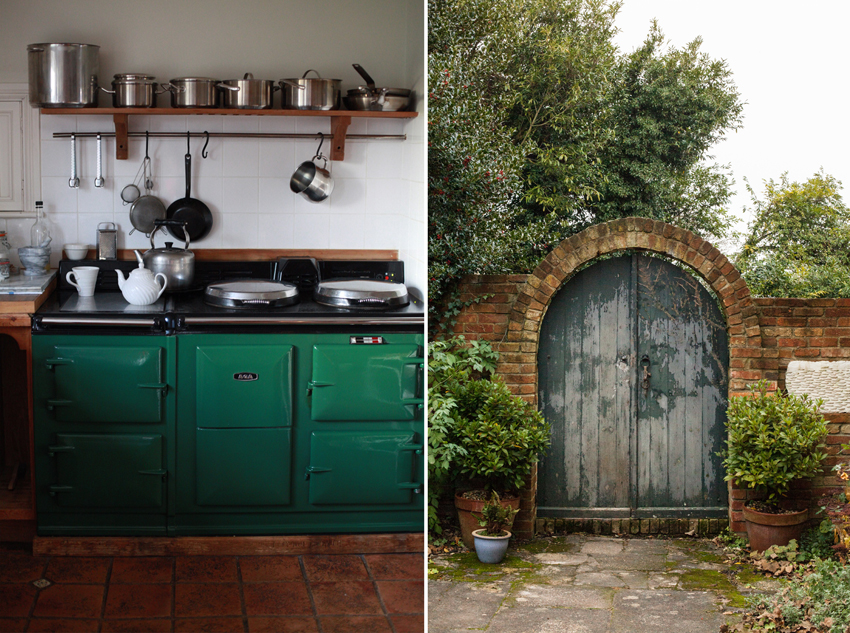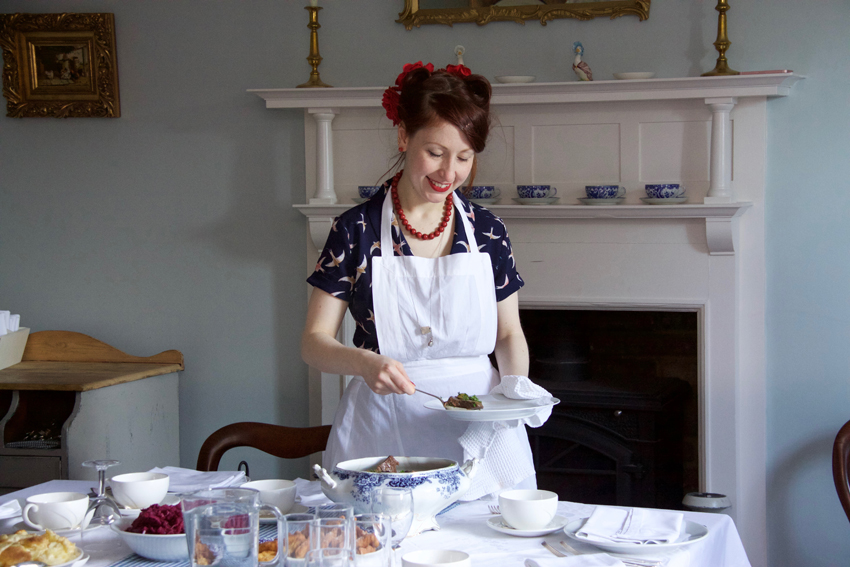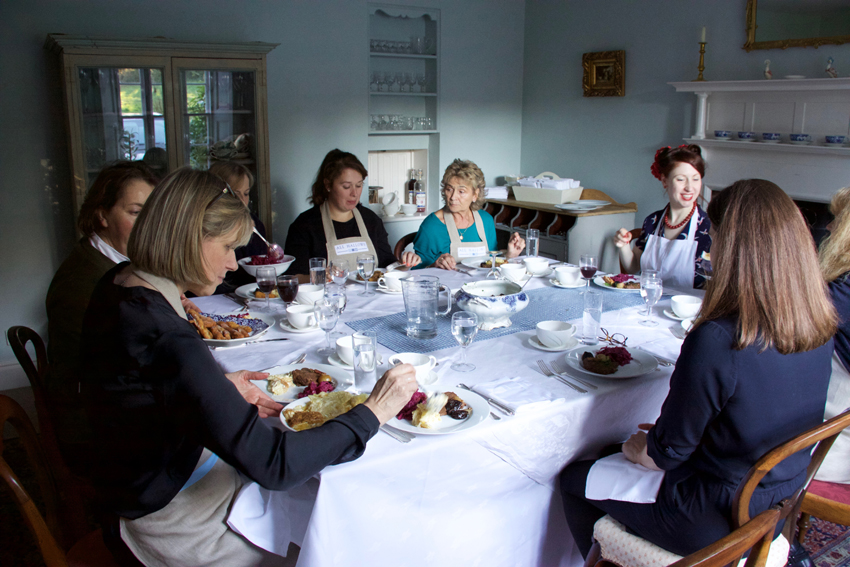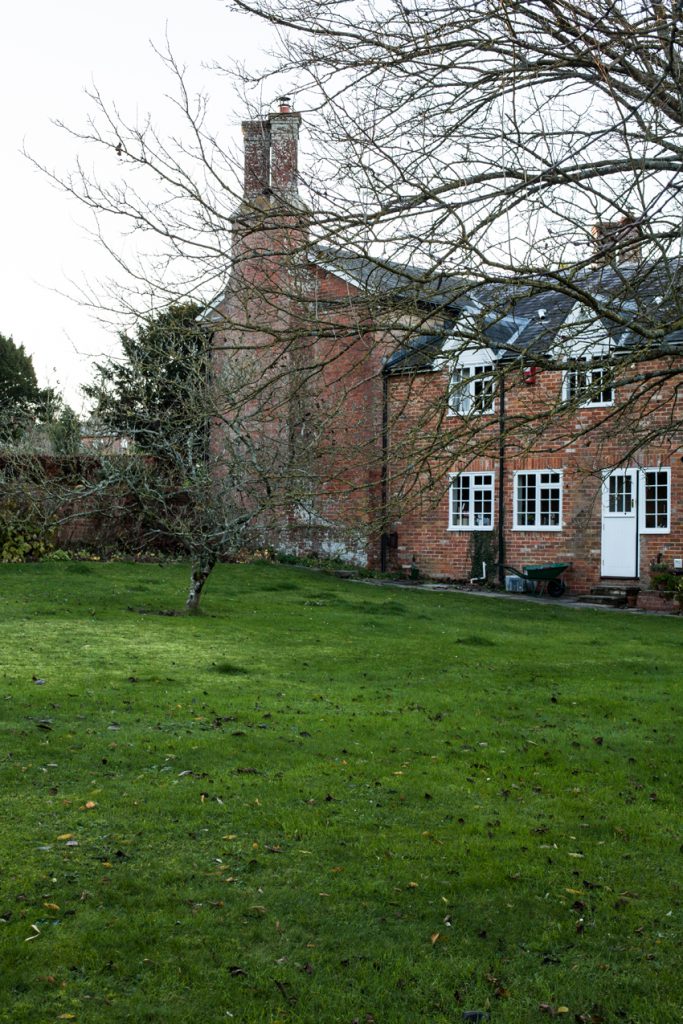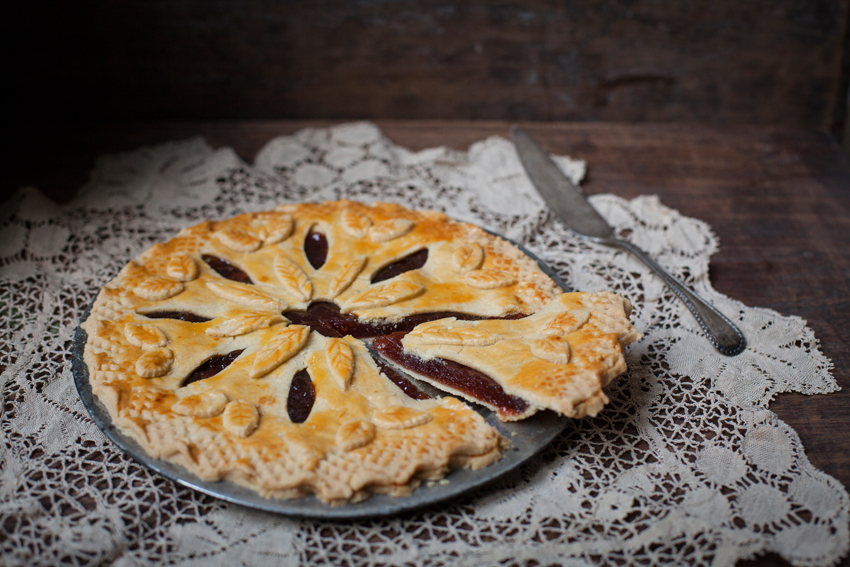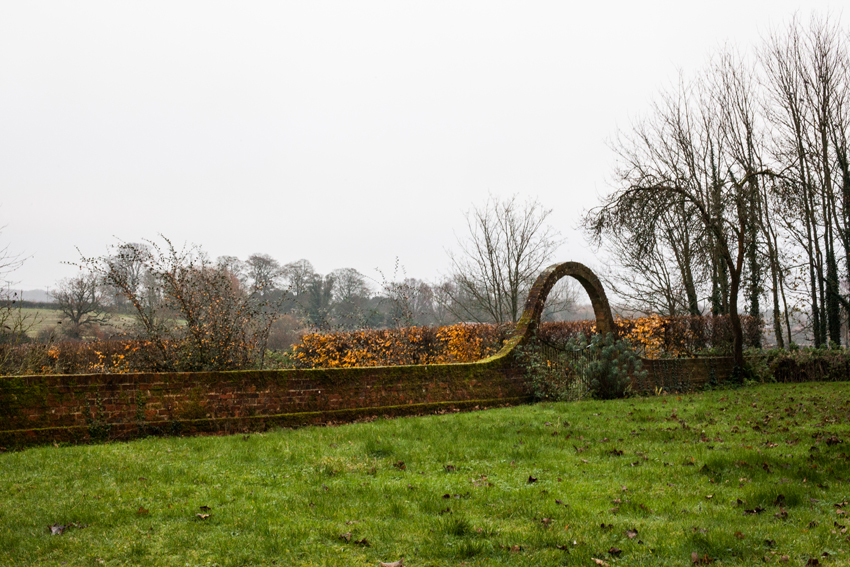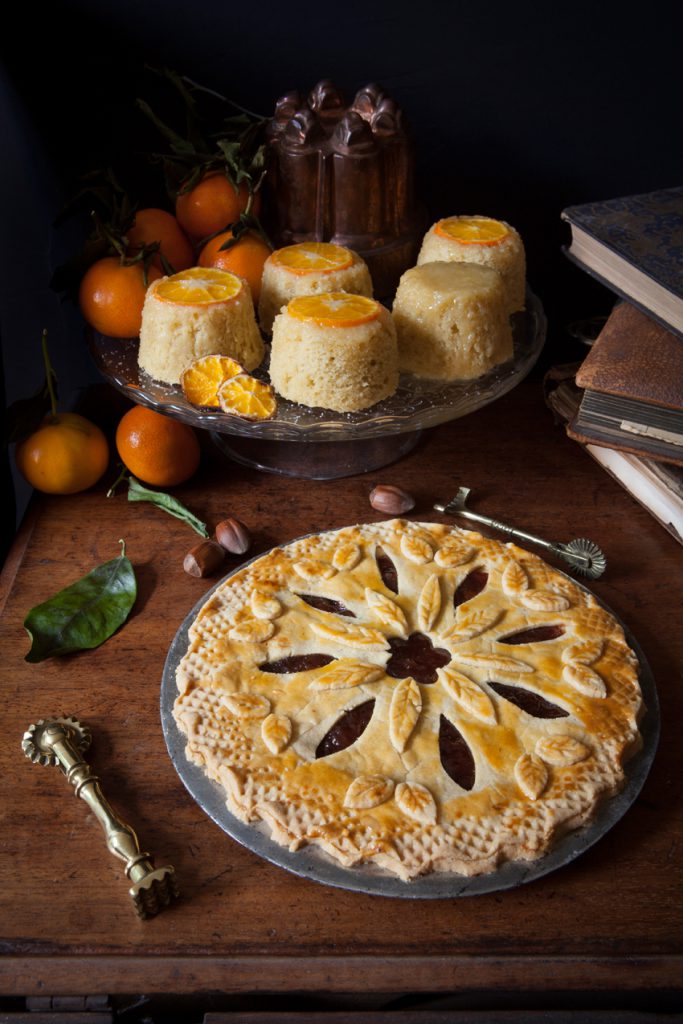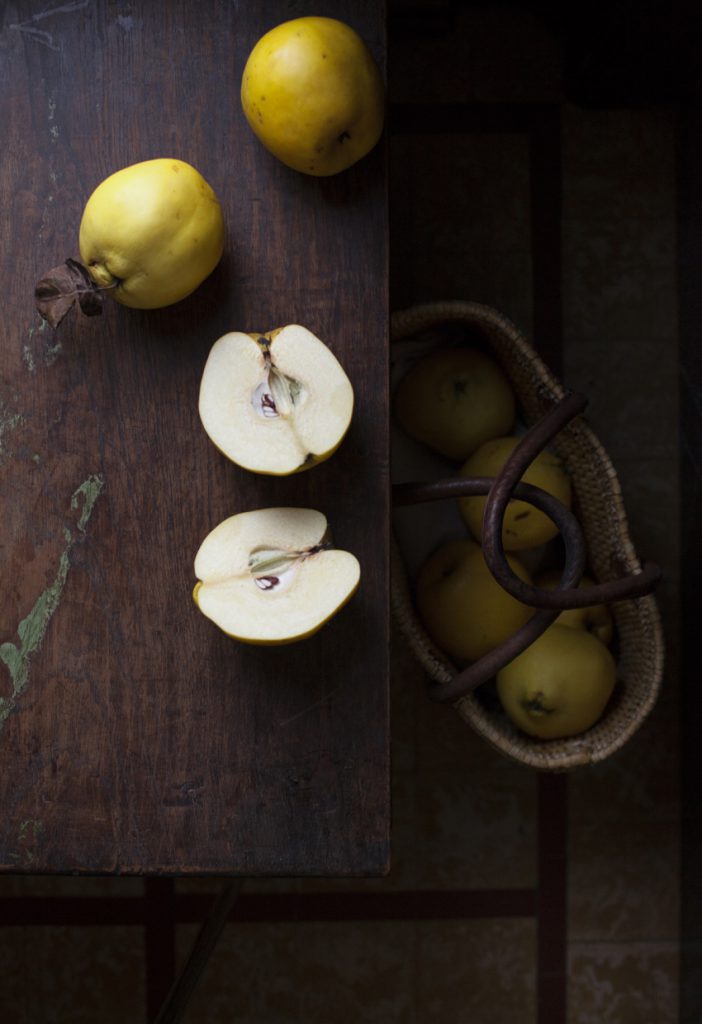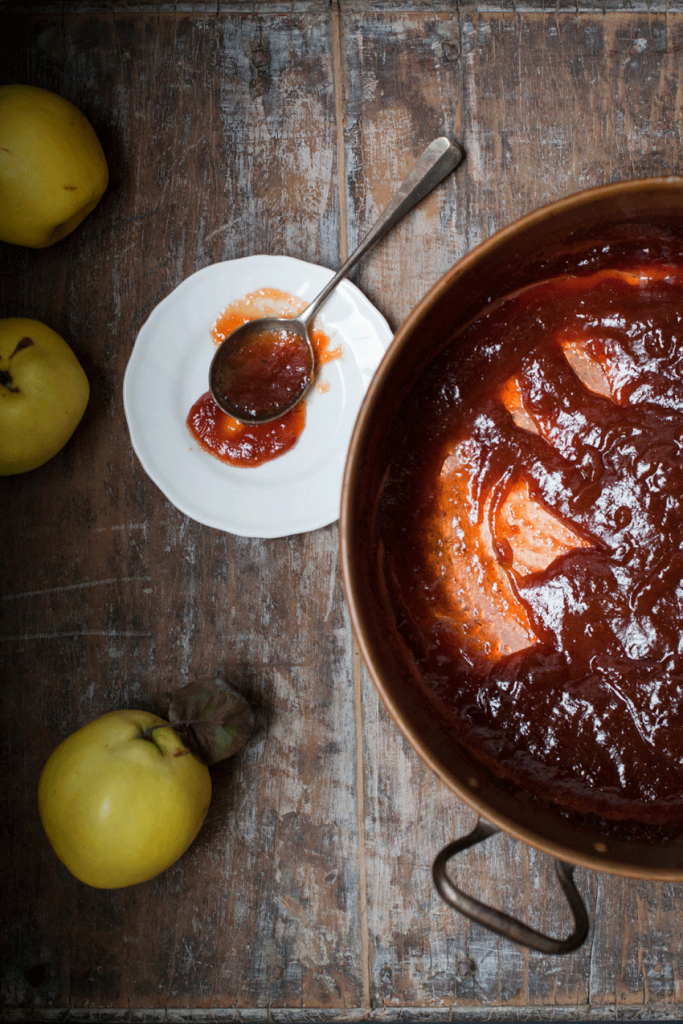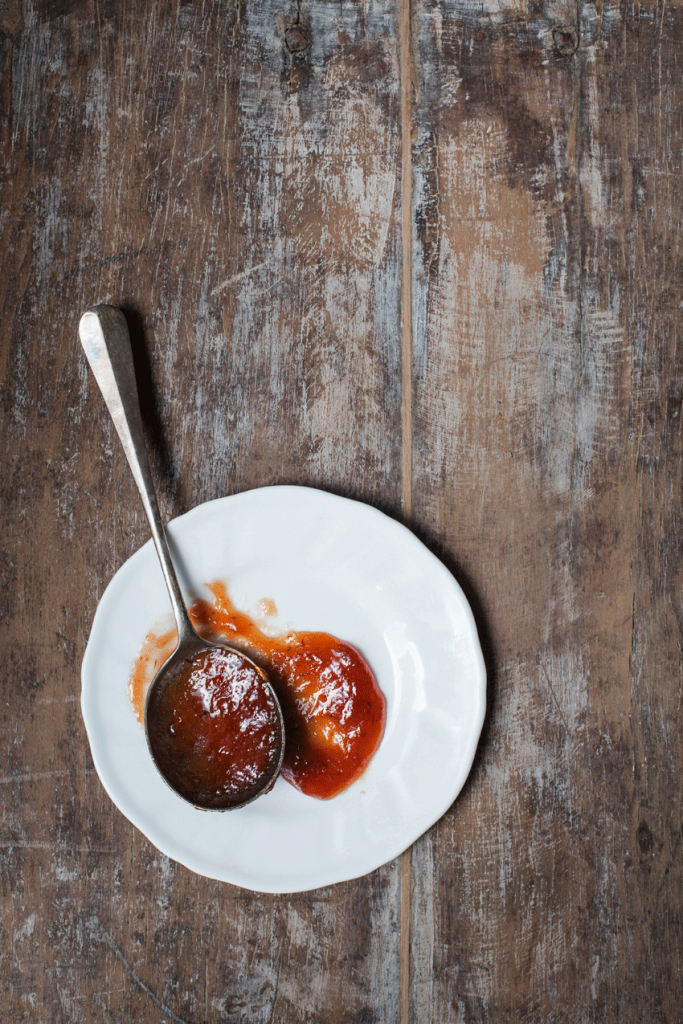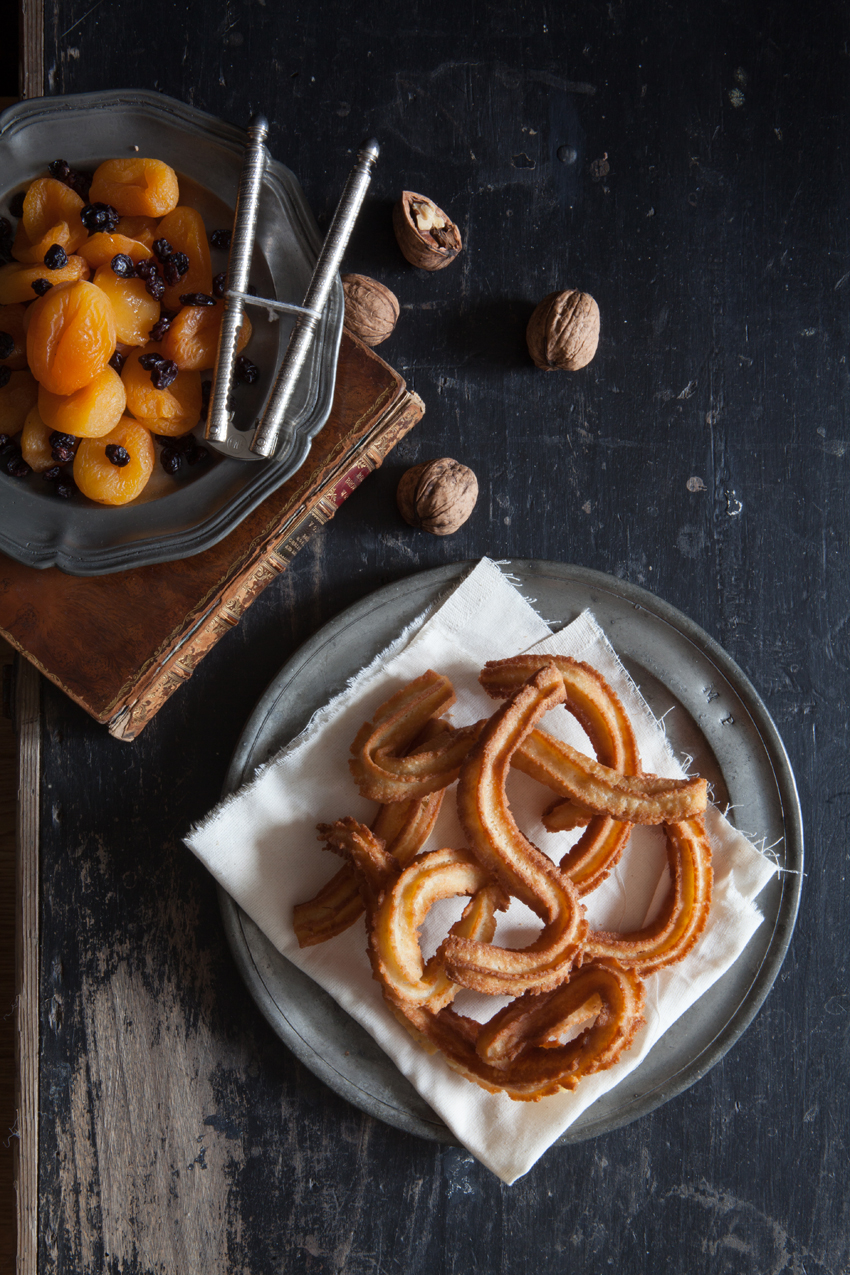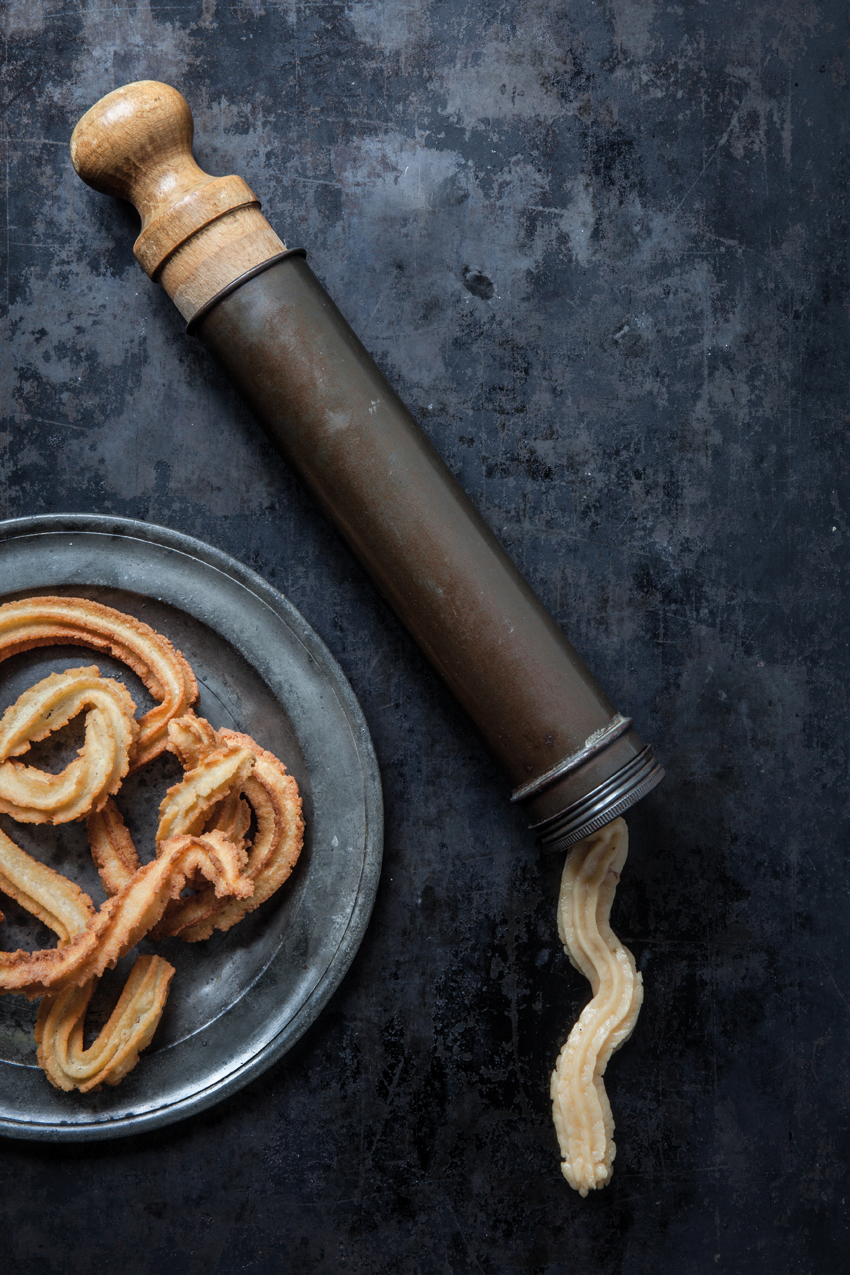The post Quince tart and our workshop in Dorset appeared first on Miss Foodwise.
]]>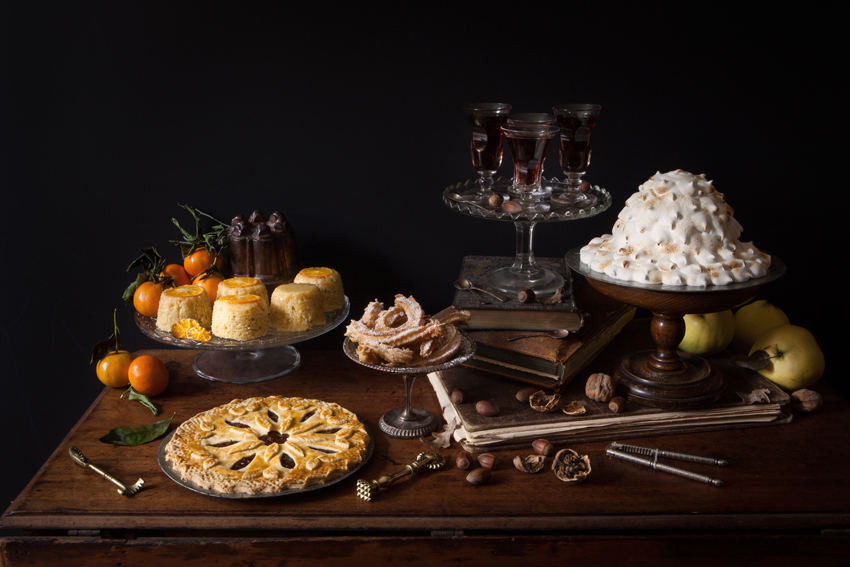
A still life of puddings I created for Borough Market Life Magazine – featuring the quince tart
Two weeks ago on a frosty yet sunny winter morning, we welcomed our workshop attendees at All Hallows Cookery School in Dorset. We started with tea and mini mince pies plus pancakes from the AGA for the early birds. It was hard to get started because we were all having so much fun getting to know each other, or catching up. We made the more delicate puddings from my book, a sweetmeat pudding – otherwise known as the Bakewell pudding, Snake fritters and a quince tart with intricate pastry work. Lunch was beef with prunes, lovingly prepared by our host and owner of the school Lisa Osman. I can’t think of a dish more fitting on a day of English cooking. After all, beef and pudding have been the icon of English food for many centuries. There was a time during the Napoleonic war when eating roast beef and plum pudding would have showed your patriotism. Visitors from all over Europe spoke with high regard about the quality of English meat and beef especially.
After our rather festive lunch in Lisa’s beautiful dining room which made me feel as if I was in a Jane Austen novel, she taught us wreath making which sounds far more easy than it actually was. We struggled and have a huge respect for wreath makers now. We all concluded we now understood why a impressive wreath is so pricy. It takes a ton of work, and will leave you with very painful hands. I finished mine at home and now have it on my front door for all to see.
We are planing more workshops at All Hallows Cookery School in the new year, so if you fancy coming to one, or gifting a workshop to a loved one, then do get in touch with Lisa. All Hallows also has a couple of beautiful rooms so you can make a weekend out of it, or if you’re in the area you can just stay at the house as she is available for bed and breakfast when she has availability.
Now on to that quince tart. I had made the quince jam at home as it takes a couple of hours to make and we didn’t have the time to do that on our day in Dorset. As I said in my previous post where I gave the recipe for quince cheese, you can use that recipe and just not let the jam dry in the oven to become paste. You can dry a part for quince cheese, and use the rest for a tart. But what you also can do is make the filling especially, and then you can use less sugar.
Elaborately decorated tarts like this one were all the rage in 17th century England. Oliver Cromwell the puritan and general partypooper would not have been pleased to see this luxurious tart on his table. He wanted people to eat more simple no-frills meals in order to be closer to god. The whole story about these kind of puddings you’ll find in my book of course. But for now here’s the recipe.
Quince tart
While the original historical recipe uses slices of quince and a syrup made out of the cooking liquid, this version using a jammy quince puree is much more to modern tastes. I’m pretty sure however that they made the same tart this way too. Why wouldn’t they!
The trick to get a beautiful dark colour is to cook the quince and the jam slowly and for a long time. The peel I’m told is also adding to the reddish colour so I never peel the fruit. I do’t remove the cores, because there is a lot of pectin in the pips to thicken the jam. But you can of course peel and core, it’s just not worth the hassle!
What do you need
Makes a 20 cm tart – I find using a enamel plate gives a better result than a pie or tart casing.
- 1 quantity shortcrust pastry, recipe in my book, or use high quality all butter pastry from the shop*
*If you are using store bought pastry you need to buy two packs if you want to make a pastry lid as well. - 3 large quinces, 600 g, roughly chopped each
- 1 cinnamon stick
- 2 cloves
- peel of 1 lemon
- 350 g raw sugar
- 1 egg, beaten, for egg washing
Method
Prepare the shortcrust pastry as instructed in my book or use shop bought. If you are using a pastry lid, don’t blind bake the pastry base. Line the pie dish with the pastry, leaving enough pastry on the rim to fasten the lid to.
Preheat the oven to 160C (315F).
In a large saucepan cover the quinces with water and boil until tender with the spices. Remove the quinces from the saucepan and save the spices (you might not even find the cloves and lemon peel as they can have disintegrated. Just remove the cinnamon.
Blend to a puree using a stick blender. Proceed as for making jam adding the sugar, put the cinnamon back in, being careful as quince jam tends to spit. A way around this is to not make the jam on a hob but first bring it to a boil and stir for 5 minutes, remove the spices, then transfer the pan covered in greasproof paper into the oven at 160°C. Leave there for 45 minutes, then check on it, it should be thick and perfect for a pie filling.
**If you see any woody bits in your puree, I would advise to strain it through a sieve. If you aren’t picky about a few bits, just leave it in.
If using a pastry lid, cut a circle of pastry the same size as the pie dish and carefully place it over the filling. Crimp the edges, or create a nice pattern using a pastry jigger if you have one. Decorate as you please.
Egg wash the pastry lid well and bake in the middle of the oven for 45-50 minutes.
Enjoy as a pudding, or an afternoon treat!
Check out other quince recipes on this website:
Quince Rataffia (quince liqueur) >
And check out Jul’s Kitchen roast quince with rice pudding here >
Special thanks to Rebecca Williams from the blog ‘Hold the Anchovies Please’, who attended the workshop and kindly allowed me to use a couple of shots of the workshop! See her post here >
The post Quince tart and our workshop in Dorset appeared first on Miss Foodwise.
]]>The post How to make Quince Cheese appeared first on Miss Foodwise.
]]>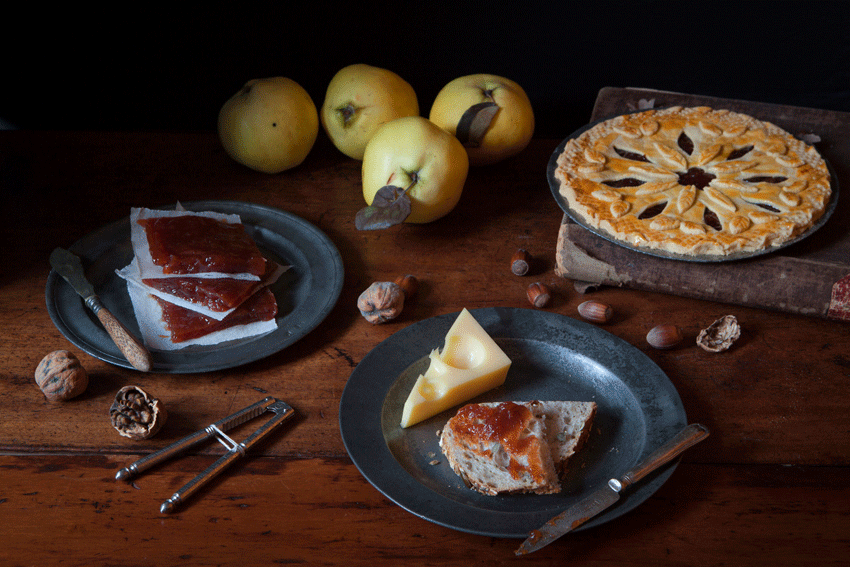 I’m not the biggest fan of sweet desserts after mains, I prefer an afternoon tea where the treats become the star of the show. That way you can enjoy them to the full and they do not become that thing you eat last when you’re actually too full to enjoy it. For an afternoon tea you can dress up, wear a hat, and pretend to be a lady of good breeding. Drinking tea with your pinky in the air, back straight, having polite conversations and enjoying the experience of eating from fine bone china. I’m also a sucker for a multi-tiered cake stand, and for clotted cream – lots of it.
I’m not the biggest fan of sweet desserts after mains, I prefer an afternoon tea where the treats become the star of the show. That way you can enjoy them to the full and they do not become that thing you eat last when you’re actually too full to enjoy it. For an afternoon tea you can dress up, wear a hat, and pretend to be a lady of good breeding. Drinking tea with your pinky in the air, back straight, having polite conversations and enjoying the experience of eating from fine bone china. I’m also a sucker for a multi-tiered cake stand, and for clotted cream – lots of it.Cheese and biscuits are my choice of afters and with a decent fruit cheese and port this quickly becomes my perfect kind of dessert.
Fruit cheeses are reduced jams or pastes. Centuries ago they were served after dinner as a digestive and they were often prescribed by apothecaries to cure minor ailments. The fruit paste was often pressed in a mould with fancy engravings and could look rather stunning. Moulds of this sort are rare to come by, I only know one person who has a mould and I believe he even carved it himself.
Although fruit cheeses should be thick and hold their shape, they should still be spreadable. You can make them into small cake trays for a nice shape or just in a large tray, you can then cut squares of the fruit cheese to wrap them and keep them. They are the most delectable accompaniment to blue cheese, but they can also be eaten all on their own, as a sweetie. A nice idea if you want to know what your child puts in its mouth, factory made sweets can contain all sorts of horrible additives. But it’s still sugar, make no mistake, to call it healthy would be wrong, but eaten and treated as a treat it is just fine.
My favourite fruit cheese is made of Quince. Quince are usually cooked and conserved. They look like otherworldly lanterns, large yellow pears with a strange downy covering. Raw they are considered quite unpalatable because of their tartness, but they are high in pectin which makes them ideal for making jams, jellies and fruit cheese. The pectin is most strong in the pips of the fruit, often ground up pips would be used to set other jelly like creations. But this is something I would not recommend you do as the seeds contain nitriles which turns poisonous when it comes in contact with your guts enzymes and acid. A few pips from your batch of quince are fine, just don’t chuck in a jar of ground up pips.
Quince and quince cheese was popular all over Europe since Medieval times. In Spain they call it ‘Membrillo’, in Italy ‘cotognata’ from the Italian word for quince ‘mele cotogne’ quince apple, the French call it ‘cotignac’ or ‘paté de coing’ from the French ‘coing’ for quince. Quinces are responsible for the word marmalade as their Portuguese word is ‘marmelo’ and they were made into fruit cheeses named marmalades.
Not only quince are used, every type of plum works great too. The Spanish love it with Manchego cheese, others prefer it with sweet cheese curds, but I prefer a good blue cheese like Stilton – the king of blue cheese, Shropshire Blue or Devon Blue.
Recipes for fruit cheeses are plentiful in historical cookery books. It was common to add red sandalwood or cochineal (a red colouring made from the cochineal beatle) to food to enhance the colour. Cochineal, also known as Carmine, was particularly popular in the Georgian and Victorian era but also in Tudor times the colouring of food was a very common practice in the kitchens of the King.
Cochineal wasn’t only used to colour food, it was also used as a textile dye and more recent to give make-up like red lipstick its beautiful red and pink colour. (Since I’ve been wearing red lipstick for half my life I’ve probably eaten quite a few of these little cochineal bugs). I have a small batch of the dried beetles sitting in a jar in my kitchen now, ready for making cochineal. I own a small Victorian Cochineal bottle and it is quite amazing to see the dye has not lost colour all these years. That must be the reason cochineal is considered the best red dye. In Italy the cochineal bugs are used to dye Alchermes, a liqueur popular in Tuscany and other regions. That liqueur is then used to dye food too, cake or lady fingers are often soaked in it. The Italian version of a Trifle, the ‘Zuppa Inglese’ is made with sponge cakes or lady fingers soaked in Alchermes.
See below a period recipe from Mr. Borella, who was the head confectioner to the Spanish Ambassador in England around 1772. He also uses Cochineal to colour his quince cheese.
To make the paste of a fine red, bake the quinces in the oven a long while, then peel and sift them in a strong hair-sieve; dry the marmalade over a slow fire a little while, to about half the consistency of a paste then to redden it the more, keep it a good while on a slow ashes-fire, stirring some time; and to add to this redness, put a little steeped cochineal, and reduce it on a flow fire, to a thick paste; that is, when it loosens from the Pan; put as much sugar as marmalade, or paste, soak it a little while on the fire and let it cool, just enough to work it well with the hands, and finish directly as usual.
Mr. Borella, The Court and Country Confectioner, 1770
The recipe below can be used two ways. You either jar the jam before it goes into the oven to dry and use it as a filling for pies (see the next posting), or you place it into the oven so it becomes fruit cheese.
The trick to get a beautiful dark colour is to cook the quince and the jam slowly and for a long time. The peel I’m told is also adding to the reddish colour so I never peel the fruit.
Quince cheese
What do you need
- 3 large quinces, 600 g, roughly chopped (you can remove the core but I do not for the extra pectin the pips contain, just take off the black crowns)
- 1 cinnamon stick
- 2 cloves
- peel of 1 lemon
- raw cane sugar, equal amount to the pulp
Method
In a large saucepan cover the quinces with water and boil until tender with the spices. Remove the quinces from the saucepan and save the spices.
Blend to a puree with cores and all to get a good set using a stick blender. Measure the quince puree and add the same weight in sugar plus the spices you saved. Proceed as for making jam, being careful as quince jam tends to spit. A way around this is to not make the jam on a hob but first bring it to a boil and stir for 5 minutes, remove the spices, then transfer the pan covered in greaseproof paper into the oven at 160°C. Leave there for 45 minutes, then check on it, it should be thick and perfect for a pie filling.
Let the puree cool so it is cold enough to handle and strain through a sieve, pushing it through with a rubber spatula. Use for pies or jam or proceed to dry the make the fruit cheese by preheating your oven to 130°C if you haven’t already.
Transfer the jam to a shallow tray which you previously lined with greaseproof paper. You can make it as thick if you want but 1 cm is definitely the minimum. Let the paste dry until you feel it is becoming firm. There is no saying how long this will take exactly but it will be around an hour at least for sure.
When ready, leave to cool and then wrap in clean greaseproof paper. Place in an airtight container and it will keep for a few months. It might cristalise a little, but that doesn’t make it bad to eat.
You want it super red?
You might have a hard time finding the cochineal beetles but you can use all natural red beetroot powder!
This is nice as an edible gift to someone special!
You might also like
Damson cheese >
Quince Rataffia >
Quince tart Coming next week!
And check out Jul’s Kitchen roast quince with rice pudding here >
The post How to make Quince Cheese appeared first on Miss Foodwise.
]]>The post Great British Bake Off – the batter of the century and a recipe for 17th century Snake Fritters appeared first on Miss Foodwise.
]]>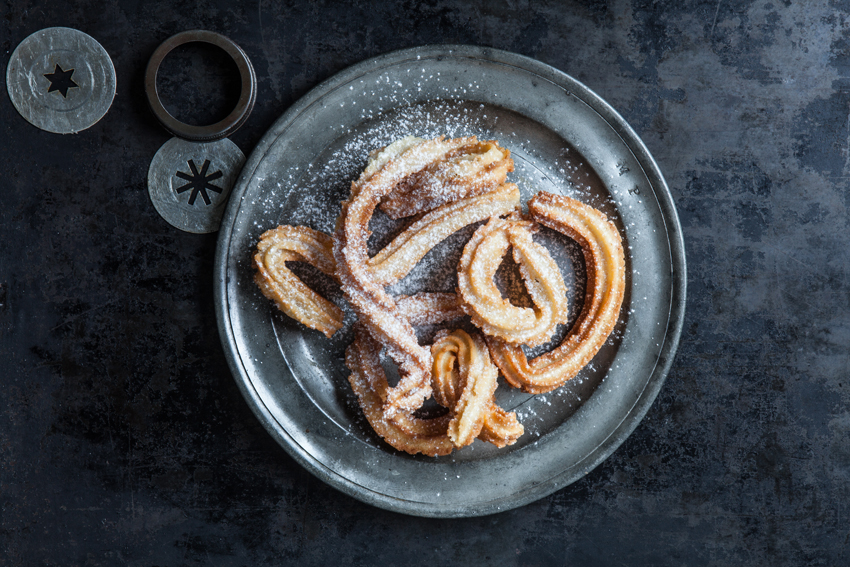 It was batter week on the Great British Bake Off. And many people felt a bit battered after the news came in yesterday that Love Productions have sold the GBBO to Channel 4. The Beeb just didn’t have the amount of cash needed to keep the bun in the oven. Mel and Sue aren’t swallowing the cake and quit with a statement full of buns, I mean puns (I just had to, sorry). And I love them for it, though they will be missed like the icing missing from an iced finger.
It was batter week on the Great British Bake Off. And many people felt a bit battered after the news came in yesterday that Love Productions have sold the GBBO to Channel 4. The Beeb just didn’t have the amount of cash needed to keep the bun in the oven. Mel and Sue aren’t swallowing the cake and quit with a statement full of buns, I mean puns (I just had to, sorry). And I love them for it, though they will be missed like the icing missing from an iced finger.
We were very shocked and saddened to learn yesterday evening that Bake Off will be moving from its home. We made no secret of our desire for the show to remain where it was.
The BBC nurtured the show from its infancy and helped give it its distinctive warmth and charm, growing it from an audience of two million to nearly 15 million at its peak.
We’ve had the most amazing time on Bake Off, and have loved seeing it rise and rise like a pair of yeasted Latvian baps.
We’re not going with the dough. We wish all the future bakers every success.
Outrage on social media, others are outraged by those who are outraged… life on social media every day.
My opinion? Yeah I’ll give it since it is my blog innit?
When Britain voted to leave the EU, I as a Belgian felt as if half the British population were basically dropping us like a scone.
What has this brexit shizzle got to do with the GBBO you say?
We watch it in Europe!!
Most people can get BBC1 and BBC2, which means I can watch Eastenders every night except wednesday. We hate wednesday because there is no Eastenders on wednesdays. (don’t judge, judging people on how they look, talk, prey or which soap they watch religiously is bad, bad, bad.)
On Channel 4, we will all loose out. I mean, first Brexit, now Bake Off.
As if Britain couldn’t make itself even more unpopular with the rest of Europe!
Luckily there have been rumours that we would maybe get our own Bake Off in Belgium! How great is that, no one can watch Great British Bake Off anymore but we can watch the Great Belgian Bake Off! I’m already excited by the idea of it. Especially since I’ve been asked to be one of the presenters of the program.
So here I am practicing my baking puns. There’s nothing set in shortcrust pastry yet but if it does happen I’ll let you know.
Back to the news of the day! Batter week! Churros!
The bakers made them into all sorts of different shapes, which didn’t really feel right to me as the whole idea is that you pipe the batter into the hot oil, not pipe + shape + then fry. But hey, you can even buy churro machines now, they look like waffle irons but shaped like sausages, so Bake Off is allowed to be creative with “what is a churro” too. But what is a churro? The first clue is that a churrera is a syringe in Spanish.
Did you know that I wrote a book full of puddings? Well they aren’t all savoury so here I’m sharing the recipe for the 17th century English version of the churros you saw on the Bake Off last night. Yes, English! Tweeting about my 17th century churros nearly caused the same kind of outrage on twitter as when Jamie added chorizo to his Paella. I was threatened to leave Spanish cuisine alone and that I am an absolute dumb-ass for suggesting they were also English… Well…
They were called snake fritters or syringe fritters and not just a dish popular in Spain. In fact they appeared at the same time in Italy, Spain, France, England, Portugal and Germany by the seventeenth century. Medieval Arabic recipes for piped fritters are also common, which makes you think that maybe the Moors are the origin of the Spanish churros. They fritters were just more popular in Spain and died out in England where they vanished from the cookery books that same century.
The first printed recipe in English for these fritters can be found in Robert May’s The Accomplisht Cook from 1660. The recipe is titled: To fry Paste out of a Syringe or Butter-squirt. A ‘butter-squirt’ was a syringe used for making decorative butter swirls. He flavours the fritters with saffron and sugar and fries them in clarified butter. Another 17th century author suggests brushing the curls with some butter and rosewater melted together, and then to ‘scrape’some sugar on them.
To fry Paste out of a Syringe or Butter-squirt.
Take a quart of fine flower, & a litle leven, dissolve it in warm water, & put to it the flour, with some white wine, salt, saffron, a quarter of butter, and two ounces of sugar; boil the aforesaid things in a skillet as thick as a hasty pudding, and in the boiling stir it continually, being cold beat it in a mortar, fry it in clarified butter, and run it into the butter through a butter-squirt.
Robert May, The Accomplisht Cook, 1660
Want a taste of the past?
You can come and see me at Abergavenny Food Festival on saturday at 10:30 and learn how to make these, or if you can’t make it, here is the recipe for you! Don’t forget to share your bakes on social media using #PrideandPudding!
Love x
Snake Fritters – taken from Pride and Pudding
Serves 2 people
- a few saffron threads
- 100 ml (3. fl oz) white wine
- 125 g (4. oz) butter
- 50 g (1. oz) raw sugar
- 225 g (8 oz/1. cups) plain
- (all-purpose) flour
- 1 teaspoon baking powder
- lard, tallow or oil, to fry
- extra sugar, to sprinkle
Soak the saffron in the wine until the wine is nicely coloured.
In a saucepan, heat the wine, butter and sugar gently and simmer until the butter is melted and the sugar has dissolved.
Take the saucepan off the heat and add the flour and baking powder. Combine well with a spatula until the mixture comes away from the pan and forms a ball, just like choux pastry.
When the dough looks silky smooth, it is done. Scoop the dough into a piping (icing) bag fitted with a large
star nozzle. Heat the lard in a deep-fryer or large heavy-based saucepan until it reaches 160ÅãC (315ÅãF), or until a tiny bit of dough dropped in the oil turns golden brown in 30–35 seconds.
Carefully but swiftly pipe a long snake of the pastry into the hot fat. Fry until golden and transfer to sheets of paper towel to absorb some of the fat. Sprinkle with sugar just before serving, or leave plain.
Some historical recipes call for extra flavourings, such as nutmeg or rosewater. I like to add a generous pinch of nutmeg to the batter when melting the butter.
How are they different from churros? They are more crunchy!
You might also enjoy
Batter puddings >
Cabinet pudding >
The post Great British Bake Off – the batter of the century and a recipe for 17th century Snake Fritters appeared first on Miss Foodwise.
]]>